APPENDIX 2: EXEMPLAR EXAM PAPER GRADE 12 NOTES - LIFE SCIENCES STUDY GUIDES
Share via Whatsapp Join our WhatsApp Group Join our Telegram GroupLIFE SCIENCES
STUDY GUIDES AND NOTES
GRADE 12
Appendix 2: Exemplar exam paper
The 2014 Life Sciences exams have a new format in line with CAPS. The Department of Basic Education has offered an example of Life Sciences Paper 1 and Paper 2 with marking memoranda.
Use these exam papers and memoranda to help you prepare for your exams:
- Answer the questions in Life Sciences Paper 1. Make sure you take a break before doing the same with Paper 2. Treat them as “real” exams by preparing yourself as if these were real exams, so have the paper, pens, pencils, eraser and other materials that you need. Time yourself so you complete each paper within the 2 ½ hours that is
allocated to them. This exercise is meant to test your own knowledge - so don’t cheat yourself by looking up the answers in the memo before you’ve finished each exam. - Use the memoranda to check whether or not your answers are correct. Note where you have got answers wrong - these are the sections of the curriculum that you need to do more work on. Go back to your textbooks and to the relevant sections of this study guide, and spend time learning the sections for which you got the lowest marks.
Paper 1
QUESTIONS
INSTRUCTIONS AND INFORMATION
Read the following instructions carefully before answering the questions.
- Answer ALL the questions.
- Write ALL the answers in the ANSWER BOOK.
- Start the answers to EACH question at the top of a NEW page.
- Number the answers correctly according to the numbering system used in this question paper.
- Present your answers according to the instructions of each question.
- Do ALL drawings in pencil and label them in blue or black ink.
- Draw diagrams or flow charts only when asked to do so.
- The diagrams in this question paper are NOT necessarily drawn to scale.
- Do NOT use graph paper.
- You must use a non-programmable calculator, protractor and a compass, where necessary.
- Write neatly and legibly.
SECTION A
QUESTION 1
1.1 Various options are provided as possible answers to the following questions. Choose the correct answer and write only the letter (A to D) next to the question number (1.1.1 to 1.1.9) in the ANSWER BOOK, for example 1.1.10 D.
QUESTIONS 1.1.1 AND 1.1.2 REFER TO THE DIAGRAM BELOW SHOWING THE STRUCTURE OF THE HUMAN EAR.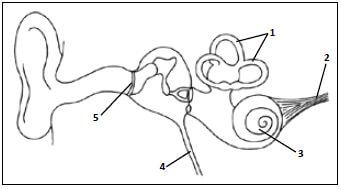
1.1.1 Which part sends vibrations to the ossicles?
A 3
B 1
C 4
D 5
1.1.2 Which part maintains equal pressure on either side of the tympanic membrane?
A 4
B 3
C 2
D 1
1.1.3 Below is a set of events following fertilisation in humans.
1. The embryo is embedded in the uterine wall in humans.
2. A zygote is formed in the Fallopian tube.
3. Cell division occurs to form a ball of several hundred cells.
4. The blastocyst remains free for several days in the uterus.
Which ONE of the following represents the correct order in which the above events occur?
A 2, 3, 4, 1
B 2, 1, 3, 4
C 3, 2, 4, 1
D 1, 3, 2, 4
1.1.4 The following are effects of the secretion of different hormones:
1. An increase in the blood glucose level
2. An increase in the heart rate
3. An increase in the amount of digestive enzymes
4. An increase in blood flow to the skeletal muscles
Which ONE of the following combinations of the above effects is due to adrenalin?
A 1, 3 and 4
B 2, 3 and 4
C 1, 2 and 4
D 1, 2, 3 and 4
1.1.5 The control centre in the body that will be activated when an athlete is dehydrated is the …
A cerebellum.
B cerebrum.
C corpus callosum.
D pituitary gland.
1.1.6 The following blood vessels carry blood to or from the placenta in humans:
1. Mother's artery
2. Mother's vein
3. Umbilical artery
4. Umbilical vein
Which blood vessels contain blood with a larger amount of oxygen and nutrients?
A 1 and 3 as compared to 2 and 4
B 1 and 4 as compared to 2 and 3
C 2 and 3 as compared to 1 and 4
D 2 and 4 as compared to 1 and 3
1.1.7 Which ONE of the following is an advantage of the testes being held in the scrotum, outside the body cavity?
A More sperm can be stored in the scrotum.
B Sperm formation is more efficient at temperatures below the normal body temperature.
C The testes are better protected in the scrotum than in the body cavity.
D There is more time for prostate secretions to be added to the sperm.
1.1.8 Meiosis in a diploid cell results in …
A four identical gametes.
B four haploid gametes.
C two different diploid gametes.
D four gametes having the same chromosome number as the parent cell.
1.1.9 The list below gives some of the stages involved in gamete and zygote formation.
1. Prophase I
2. Prophase II
3. Metaphase I
4. Fertilisation
Which ONE of the following combinations of the above stages contributes to genetic variation?
A 1, 2 and 3
B 1, 3 and 4
C 2 and 3
D 3 and 4 (9 x 2) [18]
1.2 Give the correct biological term for each of the following descriptions. Write only the term next to the question number (1.2.1 to 1.2.9) in the ANSWER BOOK.
1.2.1 The period of development of an embryo in the uterus between fertilisation and birth
1.2.2 Disease characterised by a lack of insulin production
1.2.3 Tube that connects the pharynx and the middle ear
1.2.4 A process by which nutrients become highly concentrated in a body of water, leading to increased growth of organisms such as algae
1.2.5 A stage in the development of humans in which the embryo consists of a layer of cells surrounding a cavity
1.2.6 The structure at the tip of a sperm cell containing enzymes and which makes contact with the egg cell during fertilisation
1.2.7 The gland in the male reproductive system of humans that produces an alkaline fluid to counteract the acid environment of the vagina
1.2.8 The duct leading from the testis to the urethra in human males
1.2.9 The process by which the ovum is formed through meiosis in the ovary (9 x 1) (9)
1.3 Indicate whether each of the statements in COLUMN I applies to A only, 1.4 The diagram below represents a portion of the central nervous system of B only, both A and B or none of the items in COLUMN II. Write A only, humans. B only, both A and B, or none next to the question number (1.3.1 to 1.3.6) in the ANSWER BOOK.
| COLUMN I | COLUMN 11 |
| 1.3.1 Type of development resulting in offspring that are capable of moving around after hatching | A Precocial B Altricial |
| 1.3.2 Converts glucose to glycogen | A Glucagon B Adrenalin |
| 1.3.3. Factors affecting water availability | A Destruction of wetlands B Poor farming practices |
| 1.3.4 Provides greater chances for the fusion of sperm and egg | A External fertilization B Internal fertilization |
| 1.3.5 Characteristics of vivipary | A Placenta is formed B Live offspring is born |
| 1.3.6 Examples of greenhouse gases | A Carbon dioxide B Methane |
1.4 The diagram below represents a portion of the central nervous system of humans. 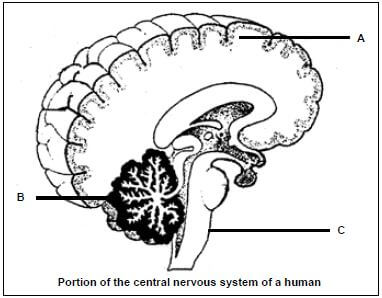
Write down the LETTER ONLY of the part which:
1.4.1 Regulates heartbeat and breathing rate (1)
1.4.2 Coordinates movement while walking (1)
1.4.3 Interprets what you see (1)
1.4.4 Has its hemispheres connected by the corpus callosum (1)
1.4.5 Controls balance and equilibrium (1) (5)
1.5 The diagram below shows the various stages in the life cycle of a human.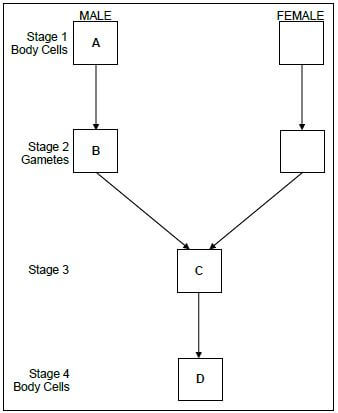
1.5.1 State the chromosome number of the cells represented by A, B and C. (3)
1.5.2 Name the structure at Stage 3. (1)
1.5.3 Between which two consecutive stages does meiosis occur in the life cycle? (1)
1.5.4 Between which two consecutive stages does mitosis occur in the life cycle? (1) (6)
TOTAL SECTION A: 50
SECTION B
QUESTION 2
2.1 Study the diagram below, which shows a reflex arc. 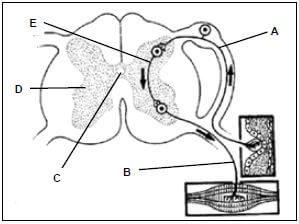
2.1.1 Give labels for each of the following:
(a) Region D (1)
(b) Neuron E (1)
2.1.2 Write down the LETTER of the part which:
(a) Transmits impulses to the central nervous system (1)
(b) Contains cerebrospinal fluid (1)
2.1.3 Explain the effect on the reflex action if part B was damaged. (2)
2.1.4 The nerve pathway in the above response is about 1,5 metres in length. A nerve impulse travels at 75 m s-1
Use this information to calculate the time taken for this reflex action to occur. Show all working. (3)
2.1.5 Explain the significance of a reflex action. (2) [11]
2.2 A learner carried out an investigation to measure the reaction time of two people (A and B). Each person had to ring a bell when a light flashed on. The time taken for each person to react was recorded and plotted on the bar graph below. The test was carried out 10 times.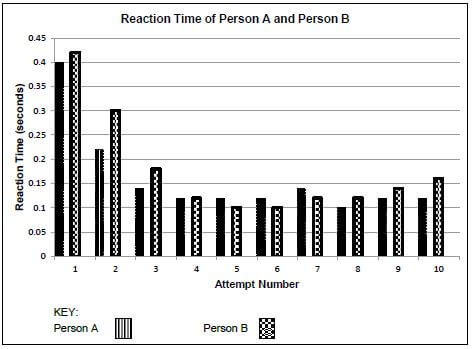
2.2.1 What was the slowest reaction time? (1)
2.2.2 Describe how the reaction time of Person B changed over the 10 attempts. (3)
2.2.3 Suggest a possible reason for the trend described in QUESTION 2.2.2. (2)
2.2.4 What was the stimulus in this investigation? (1)
2.2.5 How would the reaction time of Person A have differed if he/she had been under the influence of drugs during the experiment? (1) (8)
2.3 The diagram shows two eyes (X and Y) focused on objects (represented by arrows) at different distances from the eye. Objects A and C were 2 metres away from the eye. Objects B and D were 7 metres away from the eye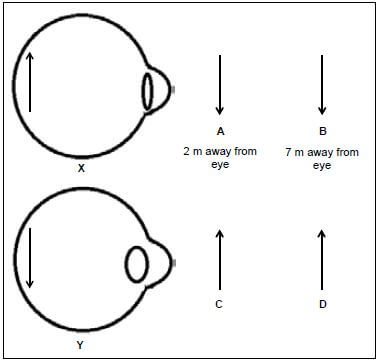
2.3.1 Write down the LETTER ONLY of the object that:
(a) Eye X is focused on (2)
(b) Eye Y is focused on (2)
2.3.2 Name and describe the process that allows eye Y to form a clear image on the retina. (5) (9)
2.4 A Grade 12 learner performed an investigation to determine the effect of light on the growth of plant shoots. The learner divided the plants that were used into three groups as follows:
Group A - The tip of the shoot was intact.
Group B - The tip of the shoot was removed.
Group C - The tip of the shoot was covered by a cap that does not allow light to pass through.
The diagram below shows each shoot at the start of the investigation and next to each, the same shoot at the end of the investigation.
The arrows indicate the direction of light in each investigation.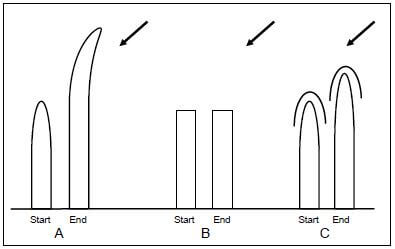
2.4.1 Name the dependent variable in this investigation.(1)
2.4.2 State TWO factors that must be kept constant in this investigation. (2)
2.4.3 The influence of which plant hormone is being investigated?(1)
2.4.4 Explain the results observed in investigations A and C, as illustrated in the diagram above. (6)
2.4.5 State TWO ways in which the learner could improve the reliability of this investigation. (2) (12) [40]
QUESTION 3
3.1 The diagram below represents the interaction between two important endocrine glands. The gland labelled A is found at the base of the brain, while the gland labelled C is present towards the front of the neck.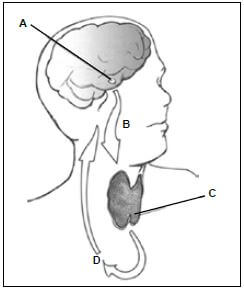
3.1.1 Give a label for gland A. (1)
3.1.2 Name hormone B. (1)
3.1.3 State TWO functions of hormone D. (2)
(1) 3.1.4 Describe the negative feedback mechanism that operates when the level of hormone D is higher than normal in the blood. (5)(9)
3.2 The diagram below shows a section through the mammalian skin.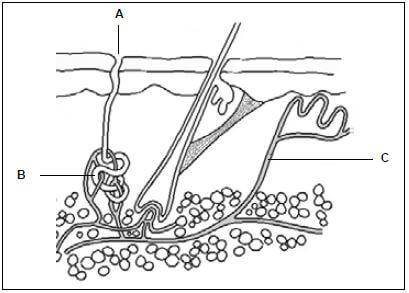
3.2.1 Give labels for parts A, B and C. (3)
3.2.2 Describe how parts B and C play a role in reducing the body temperature back to normal when it increases above the normal level. (6) (9)
3.3 The Human Sciences Research Council (HSRC) conducted a survey on food security across the provinces. The results showed that the overall percentage of food-secure households in South Africa is 45,6% as opposed to 48% in 2008.
The results, indicating the percentage of food-insecure households in each province according to the latest survey, are shown in the table below.
| Province | Food-Insecure Households % |
| Eastern Cape | 36 |
| Limpopo | 31 |
| Mpumalanga | 30 |
| Free State | 29 |
| KwaZulu-Natal | 28 |
| Northern Cape | 21 |
| Gauteng | 19 |
| Western Cape | 16 |
3.3.1 What is meant by food security? (2)
3.3.2 Use the data in the table to draw a bar graph for the four provinces that have the highest percentage of food-insecure households. (7)
3.3.3 State how the use of fertilisers by farmers can:
(a) Increase food security for a country (1)
(b) Decrease food security for a country (1)
3.3.4 State how the use of pesticides by farmers can:
(a) Increase food security for a country (1)
(b) Decrease food security for a country (1)
3.3.5 State TWO factors, other than the use of fertilisers and pesticides, which may have led to a decrease in the percentage of food-secure households in South Africa since 2008. (2) (15)
3.4 The carbon dioxide concentration in the atmosphere was recorded at 400 parts per million (ppm) in May 2013 compared to 316 parts per million (ppm) in 1958. This change is due to an increase in the use of fossil fuels as well as an increase in deforestation.
3.4.1 Describe how deforestation contributes to the high carbon dioxide concentration in the atmosphere. (2)
3.4.2 State ONE other impact of deforestation on the environment. (1)
3.4.3 Explain why we should be concerned about the rising carbon dioxide levels. (3)
3.4.4 Suggest ONE way in which the government can reduce carbon emissions caused by the generation of electricity. (1) (7) [40]
TOTAL SECTION B: 80
SECTION C
QUESTION 4
Name the hormones produced by the testes and ovaries and describe the role of each hormone in human reproduction.
Content: (17)
Synthesis: (3)
(20)
NOTE: NO marks will be awarded for answers in the form of flow charts or diagrams.
TOTAL SECTION C: 20
GRAND TOTAL: 150
MEMORANDUM
PRINCIPLES RELATED TO MARKING LIFE SCIENCES
- If more information than marks allocated is given
Stop marking when maximum marks is reached and put a wavy line and 'max' in the right-hand margin. - If, for example, three reasons are required and five are given
Mark the first three irrespective of whether all or some are correct/incorrect. - If whole process is given when only a part of it is required
Read all and credit the relevant part. - If comparisons are asked for but descriptions are given
Accept if the differences/similarities are clear. - If tabulation is required but paragraphs are given
Candidates will lose marks for not tabulating. - If diagrams are given with annotations when descriptions are required
Candidates will lose marks. - If flow charts are given instead of descriptions
Candidates will lose marks. - If sequence is muddled and links do not make sense
Where sequence and links are correct, credit. Where sequence and links are incorrect, do not credit. If sequence and links become correct again, resume credit. - Non-recognised abbreviations
Accept if first defined in answer. If not defined, do not credit the unrecognised abbreviation but credit the rest of the answer if correct. - Wrong numbering
If answer fits into the correct sequence of questions but the wrong number is given, it is acceptable. - If language used changes the intended meaning
Do not accept. - Spelling errors
If recognisable, accept the answer, provided it does not mean something else in Life Sciences or if it is out of context. - If common names are given in terminology
Accept, provided it was accepted at the national memo discussion meeting. - If only the letter is asked for but only the name is given (and vice versa)
Do not credit. - If units are not given in measurements
Candidates will lose marks. Memorandum will allocate marks for units separately. - Be sensitive to the sense of an answer, which may be stated in a different way.
- Caption
All illustrations (diagrams, graphs, tables, etc.) must have a caption. - Code-switching of official languages (terms and concepts)
A single word or two that appear(s) in any official language other than the learners' assessment language used to the greatest extent in his/her answers should be credited if it is correct. A marker that is proficient in the relevant official language should be consulted. This is applicable to all official languages. - Changes to the memorandum
No changes must be made to the memoranda without consulting the provincial internal moderator who in turn will consult with the national internal moderator (and the Umalusi moderators where necessary). - Official memoranda
Only memoranda bearing the signatures of the national internal moderator and the Umalusi moderators and distributed by the National Department of Basic Education via the provinces must be used.
SECTION A
QUESTION 1
1.1
1.1.1 D✔✔
1.1.2 A✔✔
1.1.3 A✔✔
1.1.4 C✔✔
1.1.5 D✔✔
1.1.6 B✔✔
1.1.7 B✔✔
1.1.8 B✔✔
1.1.9 B✔✔ (9 x 2) (18)
1.2
1.2.1 Gestation✔
1.2.2 Diabetes mellitus✔
1.2.3 Eustachian✔ tube
1.2.4 Eutrophication✔
1.2.5 Blastocyst✔
1.2.6 Acrosome✔
1.2.7 Prostate✔
1.2.8 Sperm duct✔/vas deferens
1.2.9 Oogenesis✔ (9 x 1) (9)
1.3
1.3.1 A only ✔
1.3.2 None✔✔
1.3.3 Both A and B ✔✔
1.3.4 B only✔✔
1.3.5 Both A and B✔✔
1.3.6 Both A and B✔✔ (6 x 2) (12)
1.4
1.4.1 C✔ (1)
1.4.2 B✔ (1)
1.4.3 A✔ (1)
1.4.4 A✔ (1)
1.4.5 B✔ (1) (5)
1.5
1.5.1
A - 46✔
B - 23✔
C - 46✔ (3)
1.5.2 Zygote✔ (1)
1.5.3 Stages 1 and 2✔ (1)
1.5.4 Stages 3 and 4✔ (1) (6)
TOTAL SECTION A: 50
SECTION B
QUESTION 2
2.1
2.1.1
(a) Grey matter✔ (1)
(b) Interneuron✔/connector neuron (1)
2.1.2
(a) A✔ (1)
(b) C✔ (1)
2.1.3 Sensation would be felt✔ but there would be no response✔ (2)
2.1.4 1,5 m ÷ 75 m.s-1✔ = 0,02✔ s✔ (3)
2.1.5 Helps to protect the body✔by reacting quickly✔ (2) (11)
2.2
2.2.1 0,42 seconds✔ (1)
2.2.2
- It decreased first✔
- then levelled off✔
- and finally increased again.✔ (3)
2.2.3 Practice makes reaction time faster✔ but later, tiredness slows down the reaction time.✔ (2)
2.2.4 Light✔(1)
2.2.5 Reaction time would probably increase✔ (1) (8)
2.3
2.3.1
(a) B✔✔ (2)
(b) C✔✔ (2)
2.3.2
- Accommodation✔ (1)
- Ciliary muscles contract✔
- Suspensory ligaments slacken✔
- Tension on lens decreases✔
- Lens becomes more convex✔
- Refractive power of lens increases✔
- A clear image now forms on the retina (any 4) (5) (9)
2.4
2.4.1 Growth of plant shoots✔ (1)
2.4.2
- Same environment in which the shoots are placed✔
- Same type of shoot used✔
(Mark first TWO only) (2)
2.4.3 Auxins✔ (1)
2.4.4 In investigation A:
- Light from the right✔
- caused auxins to move to shaded side of the shoot✔
- leading to increased cell elongation and division✔
- There was therefore greater growth on the shaded side✔
- thus bending the shoot in the direction of the source of light✔ (any 4)
In investigation C:
- Light has no influence on the distribution of auxins✔
- therefore the shoot grew upright✔ (2) (6)
2.4.5
- Repeat the investigation✔
- Use more than one plant for each treatment✔
(Mark first TWO only) (2) (12) [40]
QUESTION 3
3.1
3.1.1 Pituitary gland/hypophysis✔ (1)
3.1.2 B - TSH/thyroid-stimulating hormone✔ (1)
3.1.3
- Controls metabolism✔
- Influences heart rate✔
- Influences functioning of central nervous system✔
(Mark first TWO only) (any 2) (2)
3.1.4
- High levels of thyroxin is detected✔by the hypophysis
- which leads to a decrease✔
- in the secretion of TSH✔
- Activity of thyroid is slowed down✔ /less thyroxin produced
- Thyroxin level drops✔ to normal (5)
3.2
3.2.1
A - Sweat pore✔
B - Sweat gland✔
C - Blood vessel✔ (3)
3.2.2
- Impulses sent from hypothalamus✔to C (blood vessels)
- Blood vessels dilate✔/vasodilation occurs
- More blood carrying heat comes to the skin surface✔
- and therefore more heat is lost from the body✔
- B (Sweat glands) produce more sweat✔
- When sweat evaporates from the skin surface ✔
- More heat is lost from the skin✔
- leading to a drop in the body temperature✔ (any 3) (6) (9)
3.3
3.3.1 Having access to enough foodon a daily basis, so as to ensure healthy living✔ (2)
3.3.2 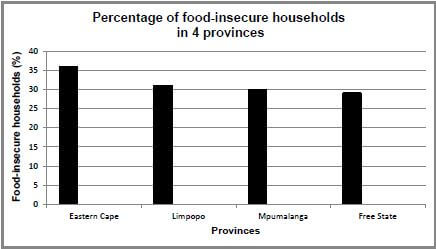
Mark allocation for the graph 3.3.3
| Criterion | Elaboration | Mark |
| Type of graph | Bar graph drawn | 1 |
| Data used | Graph drawn for four provinces only (EC, LIM, MPU and FS) | |
| Caption | Includes both variables: 'Provinces' and 'Percentage food-insecure households'. | 1 |
| X-axis | Appropriate scale AND Correct label: Provinces | 1 |
| Y-axis | Appropriate scale AND Correct label and unit: Food-insecure households(%) | 1 |
| Plotting of points | 1-3 bars plotted correctly - 1 mark All 4 bars plotted correctly - 2 marks | 2 |
3.3.3
(a) Fertilisers provide nutrients that increase crop growth✔
(b) Fertilisers are expensive - causes food prices to increase✔/ over-use of fertilisers can cause oxygen deprivation in soil which will eventually reduce crop production
3.3.4
(a) Pesticides ensure that pests do not cause large-scale damage to crops✔
(b) Pesticides could kill pests as well as their predators - hence more pesticides would have to be used, raising the cost of food✔
3.3.5
- Massive unemployment in the country✔
- Increase in the size of the human population✔
- Farms destroyed for development✔
- Decrease in subsistence farming ✔
- Prolonged unfavourable environmental conditions✔
(Mark first TWO only) (any 2 x 1)
3.4
3.4.1
- There will be less trees✔
- so less carbon dioxide will be used from the atmosphere for photosynthesis✔
3.4.2
- Can lead to the loss of biodiversity✔/habitat destruction/soil erosion
(Mark first ONE only)
3.4.3
- Increased carbon dioxide levels lead to the enhanced greenhouse effect✔
- which causes an increase in the global temperatures✔
- This could lead to rise in sea levels because of melting ice✔/ floods/change in climate
- which can lead to the extinction of some organisms✔. (any 3)
3.4.4 Use alternate sources of energy✔
(Mark first ONE only)
TOTAL SECTION B:
SECTION C
QUESTION 4
Testosterone✔
Produced by seminiferous tubules✔ in the testes
During puberty testosterone stimulates:
- The deepening of the voice as vocal cords elongate in the larynx✔
- The development of muscles✔
- The growth of facial, pubic and body hair✔
- Development of the penis and testes✔
- The production of sperm in the testes✔ max (5)
Oestrogen✔
Produced by the Graafian follicles✔ in the ovaries
- Causes the lining of the uterus✔/endometrium
- to become thicker/more vascular ✔
- in preparation for a possible implantation of the embryo and development of the foetus✔
During puberty oestrogen stimulates:
- The widening of the pelvis/hips✔
- The growth and development of the breasts✔
- The growth of the female sex organs✔
- The start of the menstrual cycle, ovulation and menstruation✔ max (7)
Progesterone✔
Produced by the corpus luteum✔ and placenta✔
- Progesterone causes further thickening of the endometrium✔
- so that it is ready for implantation of the embryo should fertilization occur✔
- High levels of progesterone✔
- inhibits the secretion of FSH✔
- by the pituitary gland✔
- which in turn prevents the further development of any new ovum in the ovary✔ max (5)
Content (17)
Synthesis (3)
(20)
ASSESSING THE PRESENTATION OF THE ESSAY
| Criterion | Elaboration | Mark |
| Relevance | No other hormone except testosterone, oestrogen and progesterone mentioned | 1 |
| Logical sequence | Each hormone named is linked to its correct role | 1 |
| Comprehensive | All three correct hormones mentioned at least three roles described for each hormone | 1 |